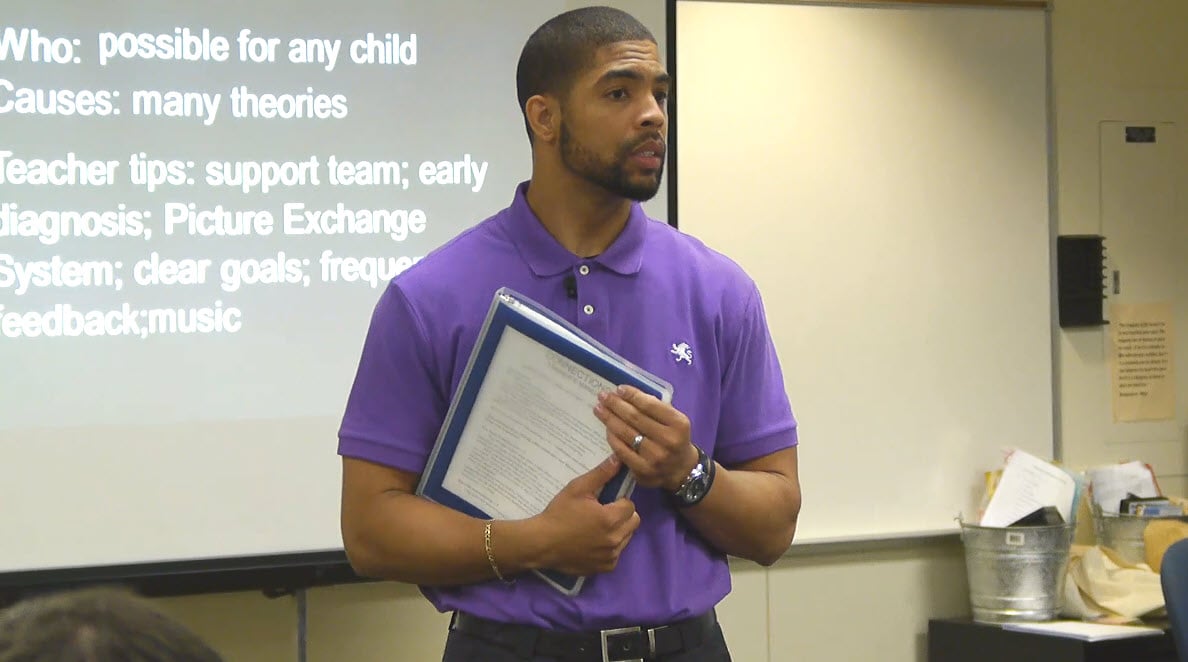



If you’re considering becoming a teacher so that you can spend the remainder of your career in the classroom, you’ve likely come across the first thing you need to do to make this happen.
Enroll in a teaching credential program.
But what is a teaching credential program? And, aren’t they all the same?
NO! Despite having to follow the same Texas regulations, not all are created equal.
Here’s what you need to know about how a teaching credential program helps you earn your teacher credential, and what to look for to ensure you enroll in the best program.
A teaching credential program provides you with the necessary training and in-classroom experience to become a teacher. In Texas, teaching credential programs are also referred to as educator preparation programs (EPP) or an alternative teacher certification program.
Texas, teaching credential programs are also referred to as educator preparation programs (EPP) or an alternative teacher certification program.
Most people who enroll in teaching credential programs do not have a bachelor’s degree in education. Instead, they earned their bachelor’s degree in another field and have decided to become a teacher straight out of college. Some people maybe looking for a career change and some may also be exiting the military or coming out of retirement to teach.
In fact, alternative teacher certification programs are a popular way to earn your teaching license in Texas, with more than 50% of all new teachers choosing this pathway toward certification.
Some teaching credential programs are solely online, while others offer in-person training or a combination of both settings. To earn a teaching license, the program must be approved by the Texas Education Agency (TEA), the state agency that oversees primary and secondary public education.
The Texas Administrative Code sets the requirement for who may enroll in an educator preparation program. You must:
If you do not have a bachelor’s degree, you can still qualify for an EPP. If you have an associate’s degree, you must have at least two years of full-time wage-earning experience within the past 10 years in the field you plan to teach. If you have no degree, you must have five years of experience.
You must also have a current license in order to teach Health Science Technology, Criminal Justice or Cosmetology.
In Texas, an approved educator preparation program must provide interns with 300 hours of training for them to earn a teaching certificate. Texas Administrative Code does allow prior degrees, military service, paid work experience and specific training to count toward this total in some cases.
teaching certificate. Texas Administrative Code does allow prior degrees, military service, paid work experience and specific training to count toward this total in some cases.
Of these 300 hours, 30 hours are required to be mentor-observed classroom teaching time.
(The 30 hours of mentor-observed classroom time should not be overlooked. See the Teacher Training section below for more information on why this is important.)
There are also requirements that a prospective teacher must meet to enroll in a teaching credential program. The Texas Administrative Code states that an individual must:
Texas Administrative Code does allow for some exceptions to this enrollment rule. If you do not have a bachelor’s degree, you can still qualify for a teaching credential program if you have an associate’s degree. In this case, you must have at least two years of full-time wage-earning experience within the past 10 years in the field you plan to teach. If you do not have a degree, you must have five years of experience.
If you do not have a bachelor’s degree, you must also have a current license in order to teach Health Science Technology, Criminal Justice or Cosmetology.
Above, we outlined the required training teaching credential programs must offer (300 hours of training, 30 of which is mentor-observed classroom teaching time), but this is where teaching credential programs forge different paths.
Which path you’re on as a teaching intern can have a significant path on how you perform as a teacher in the classroom.
Let’s begin with the training hours themselves. The 30 hours of observation by a teacher advisor is a very important part of your certification process. These teacher advisors will send information to your program that you are ready or not ready to teach in the classroom.
ECAP has former principals, vice principals and teachers who have extensive experience to help you through this process. Not all programs do this. Some simply send past teachers who are even ex-students of their program to evaluate you, so it is important to contact the program you are considering to ensure that you are going to get the best advisor to help you.
Certification requirements often change in the state. While the intention may be to strengthen the field of education in Texas, these certification updates create a burdensome process for aspiring teachers.
It’s important to enroll in a teaching credential program that is on top of the changing landscape of education in Texas … and a program that can make sure you are doing what you need to do when you need to do it.
For example, if you are considering becoming a teacher, now is the time to complete your teacher education program. The Texas State Board for Educator Certification recently adopted a new requirement that aspiring educators must meet before becoming certified. Instead of taking the PPR, teaching candidates will be required to complete the edTPA. (The requirement to take edTPA in place of the current PPR test is currently set for the 2023-24 school year)
Unlike the PPR, the edTPA is not a one-time exam. Instead, the edTPA requires that student interns prepare a portfolio of materials during their learning experiences, primarily their student teaching internships where they work directly with students.
Now and during the 2022-23 school year, teaching candidates will have the option of either taking the PPR or choosing the edTPA assessment. During the 2023-24 school year, teaching interns must incorporate the edTPA assessment into their certification requirements. Beginning with the 2024-25 school year, the TEA will implement a new cut score.
It has not been finalized yet whether you will have only one chance to attain a mark above this cut score. There is a chance that if you do not achieve the cut score the first time, despite your training, you will not earn your certification.
Texas Certification Programs, like ECAP, train the intern in completing their portfolio using real data and video, yet the intern cannot be assisted while creating their final submitted portfolio. This means that each candidate will have to actually go through the exercise twice. Once to learn the logistics, and again to put the submitted product together. Interns cannot use their ECAP, or any other certifications program, video or data for their portfolio submission. It’s a cumbersome process and takes a full semester to compile.
These rigorous requirements are designed to strengthen the field of teaching in Texas, but some interns may face a significant setback in their journey toward earning a teaching license. If you’re considering becoming a teacher, it’s important to apply to an EPP now while you still have the option of taking the PPR or completing the edTPA requirements.
As part of the requirements to earn certification, you must pass a series of exams. Which ones you must take depends on the area of certification you are seeking.
Every student intern must take at least one content test to earn a single subject teaching credential. However, while you can become certified in a single subject, such as special education or science, but can also earn a multiple subject teaching credential by taking multiple content exams. You must also take either the PPR or edTPA (see above).
You may also need to take the Science of Teaching Reading exam if you plan to teach at the elementary level or in one of a few other subject areas. You can read more about each of these exams in our article, List of Texas Teacher Certification Tests: What You Must Take To Teach.
The best teacher preparation programs will offer preparation for these important tests as part of the curriculum … not as costly add-ons.
As we emphatically answered at the top, no, not all teaching credential programs are the same. Here’s why.
If you’re enrolled in an educator preparation program, under Texas law, the required training includes:
The 30 hours of observation by a teacher advisor is a very important part of your certification process. These teacher advisors will send a recommendation to your program that you are ready or not ready to teach in the classroom.
ECAP has former principals, vice principals and teachers who have extensive experience to help you through this process. Not all programs do this. Some simply send past teachers who are even ex-students of their program to evaluate you, so it is important to contact the program you are considering to ensure that you are going to get the best advisor to help you.
The last thing you need is a poor teacher advisor that signs off on your ability to teach in the classrooom. This ends up putting you in a bad situation when a school hires you and they determine you’re not ready. What do you think the school will do with you at that point?
Also, double check that there are in-field advisers who are accessible to you throughout the school year so they can provide feedback as they visit you in the classroom. This can help you grow as an educator.
Teaching credential programs can vary in a number of other ways as well:
Some teaching credential programs may also have developed relationships with local school districts. Because the goal of any teacher certification program should be to put you at the front of a classroom. Programs that have built relationships with school districts in Texas often are the first to know about any openings. In fact, many districts will contact reputable teacher certification programs to ask for recommendations of students to hire.
Now that you know what a teaching credential program is and why they are all not the same, here are five questions to ask a program you are considering to ensure you have the best experience as an intern.
The path toward certification includes three components: Training, testing and teaching. The best teaching credential programs will have interns work on these simultaneously using a full-circle approach.
While some training must be completed prior to testing and student teaching, other parts of training can be completed while in the classroom as a teacher of record. This approach is comprehensive and efficient, and allows interns to complete a program more quickly.
Many interns who enroll in a teaching credential program have jobs, families and other important life circumstances to consider. Know about a program’s flexibility in regards to how the curriculum is taught is important to know up front.
A full online program is more likely to have the most flexibility, where as a full in-person program will have a set schedule for interns. The best programs offer both, providing you with the flexibility you need, but the benefits that come with in-person learning. These include opportunities to network and collaborate, as well as the chance for hands-on learning, and in many cases, the ability to interact with actual principals and teachers.
As we mentioned above, the importance of your advisors should not be overlooked. Although an in-field advisor is mandated by the state of Texas, how available these advisors are to you can differ based on the program.
The best teaching credential programs will ensure advisors make periodic classroom visits to observe your teaching and provide feedback, as well as provide you with experienced advisors who have been teachers, principals and vice principals.
Tip: Look for a program that actively promotes advisors and their credentials on its website.
Testing is an important part of the certification process. You will need to pass a content test and a Pedagogy and Professional (PPR) test. You may be required to pass additional exams depending on your certification area. (You can read more about these exams in our article, List Of Texas Teacher Certification Tests: What You Must Take To Teach.)
While some teaching credential programs offer test preparation help, they do so as an add-on cost. Instead, look for a program where test preparation is standard and part of your training.
If a program offers a canned response that could apply to any intern, that could be a red flag. What’s important to take away from this question is that your timeline shouldn’t look the same as every other intern’s timeline. A teaching credential program should offer you a customized plan just for you.
This customized timeline not only helps you stay on target to achieve your goals, but also represents what certifications you wish to earn and a roadmap for success.
Keep in mind that your timeline should include items like:
Your timeline should be detailed and complete with all the pieces needed to earn a teacher certification. This is where an experienced teaching credential program comes in. A program that is by your side every step of the way will set it apart from other credential programs and help to ensure your goal of becoming an educator stays on track.
Topics: Becoming A Teacher, Teacher Training
Micah is the Director of Curriculum & Technology. He holds a Bachelor of Arts in British Literature, from the University of North Texas and a Master of Arts in Teaching, from Louisiana College. In his previous career, Micah served for 14 years as a banker and bank manager. For the majority of this period, Micah managed the Downtown Fort Worth location of Frost Bank. In 2005, Micah finally surrendered to his true calling to be an educator. After a brief, but fulfilling term teaching high school English at Flower Mound High School in Lewisville ISD, Micah went to work for the family business, training teachers.
7166 Baker Blvd., Suite B · Richland Hills, Texas 76118
Phone 817-284-7731 | Fax 817-284-3396
Login | Make Payment | ECAP Handbook | Privacy Policy | Pricing
Your Comments